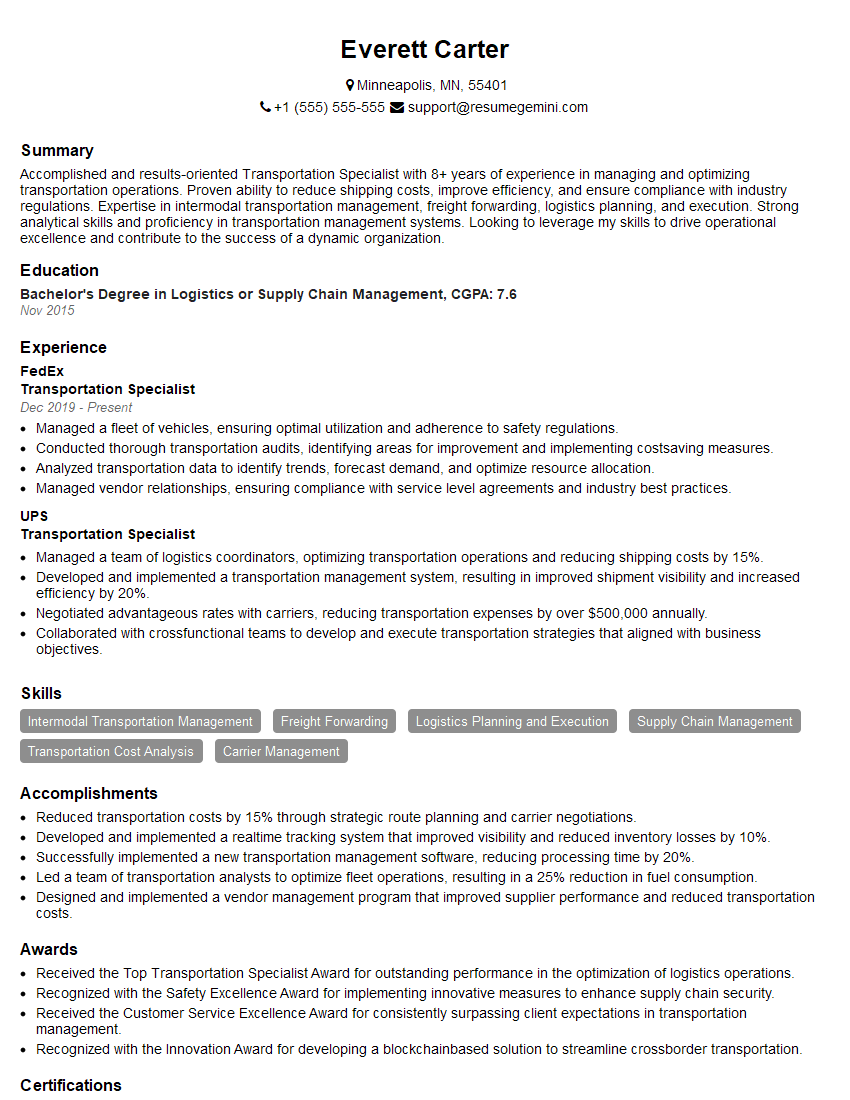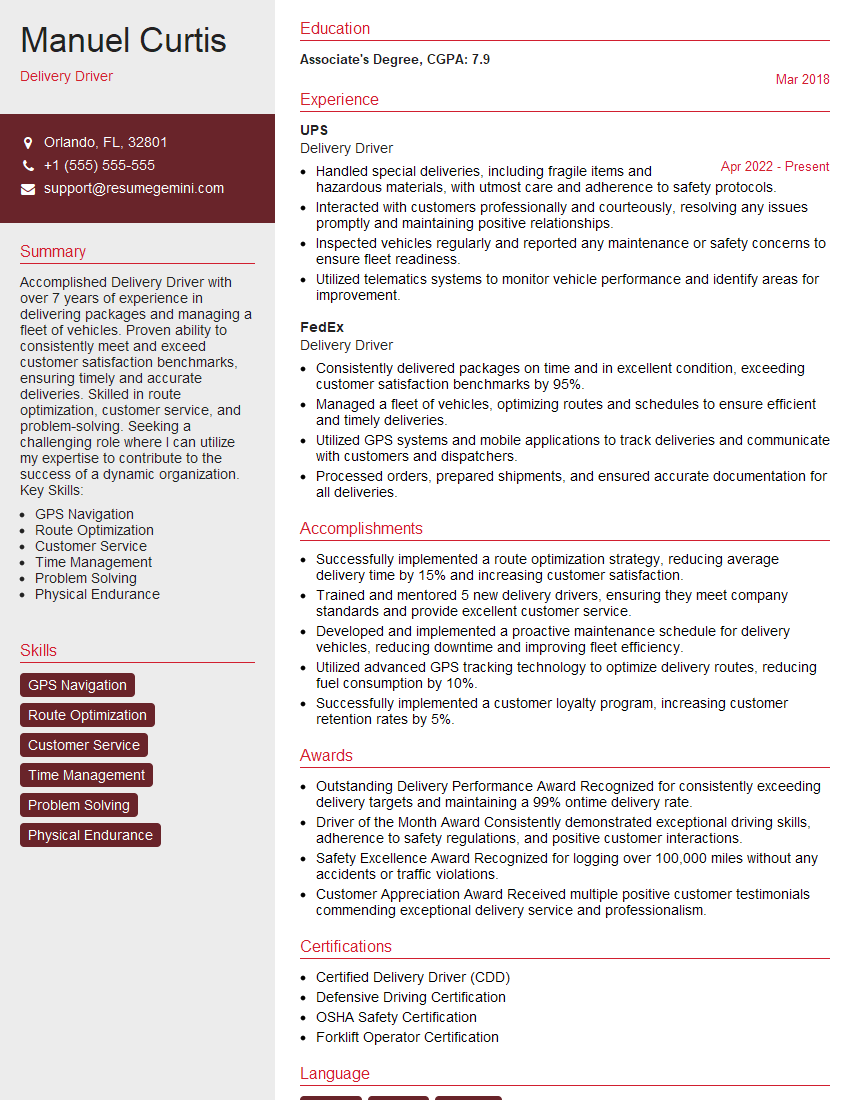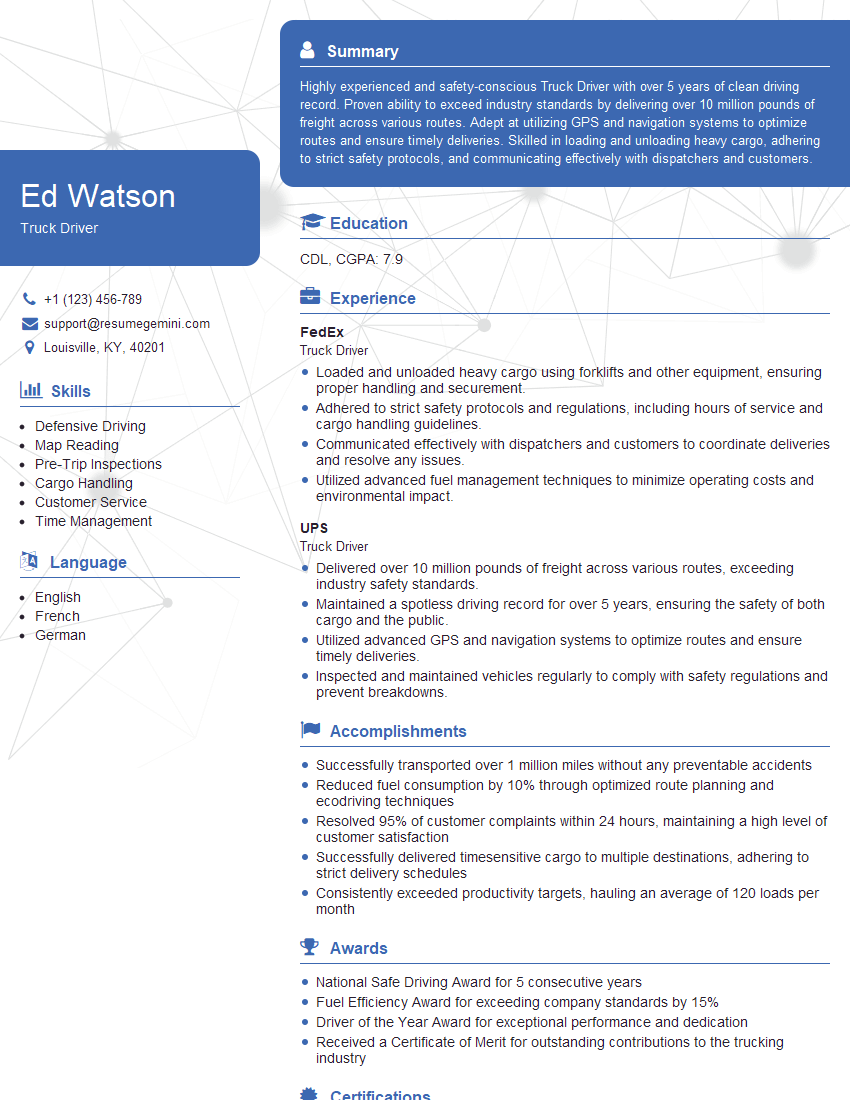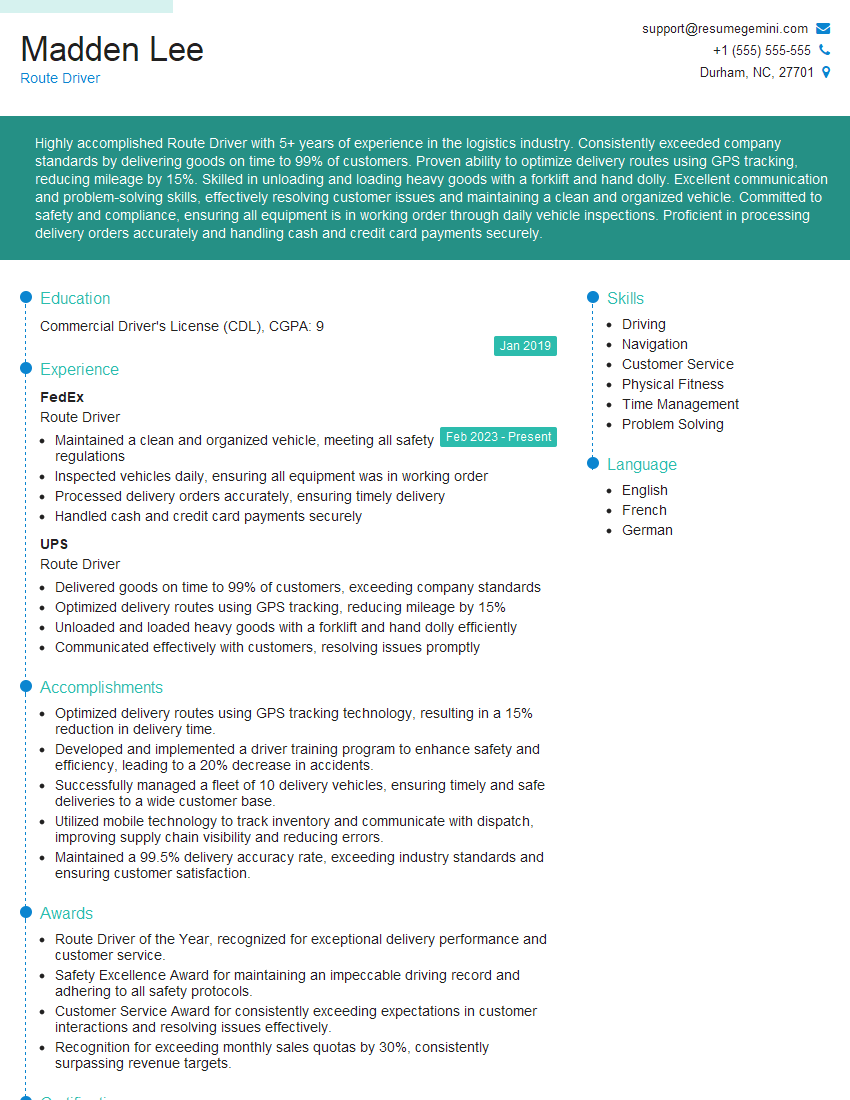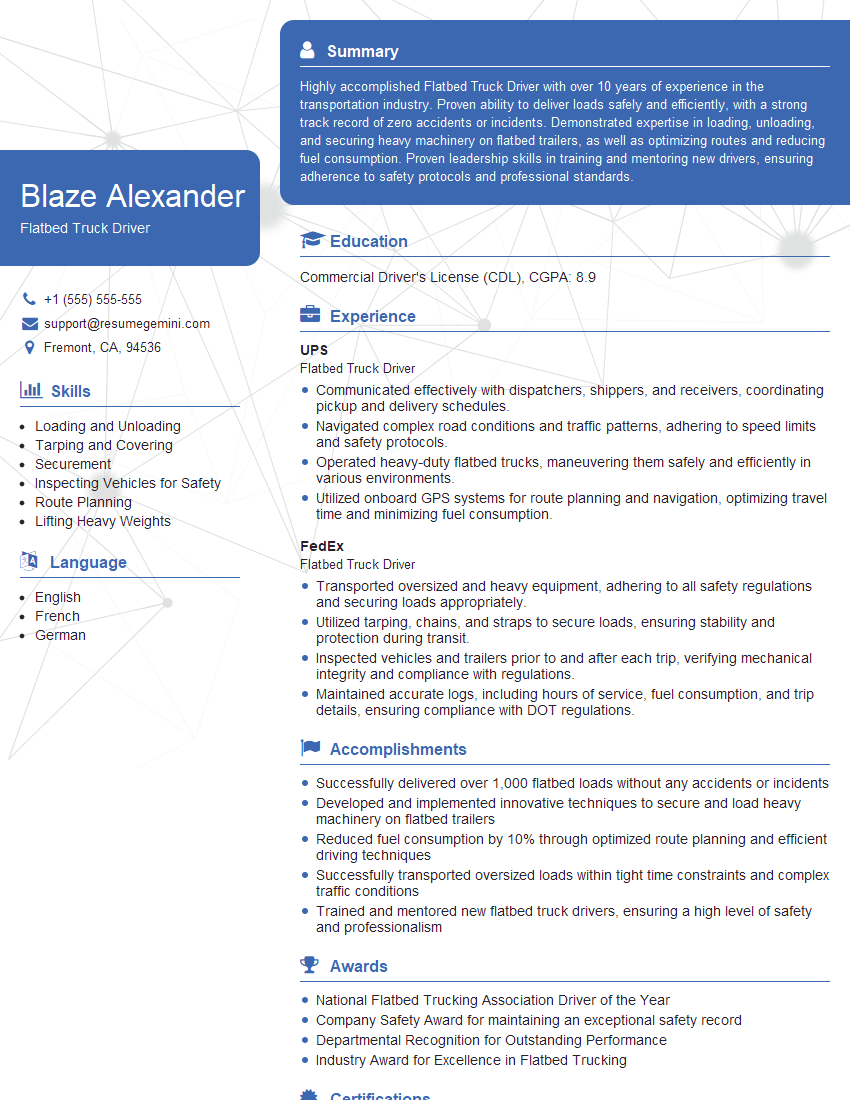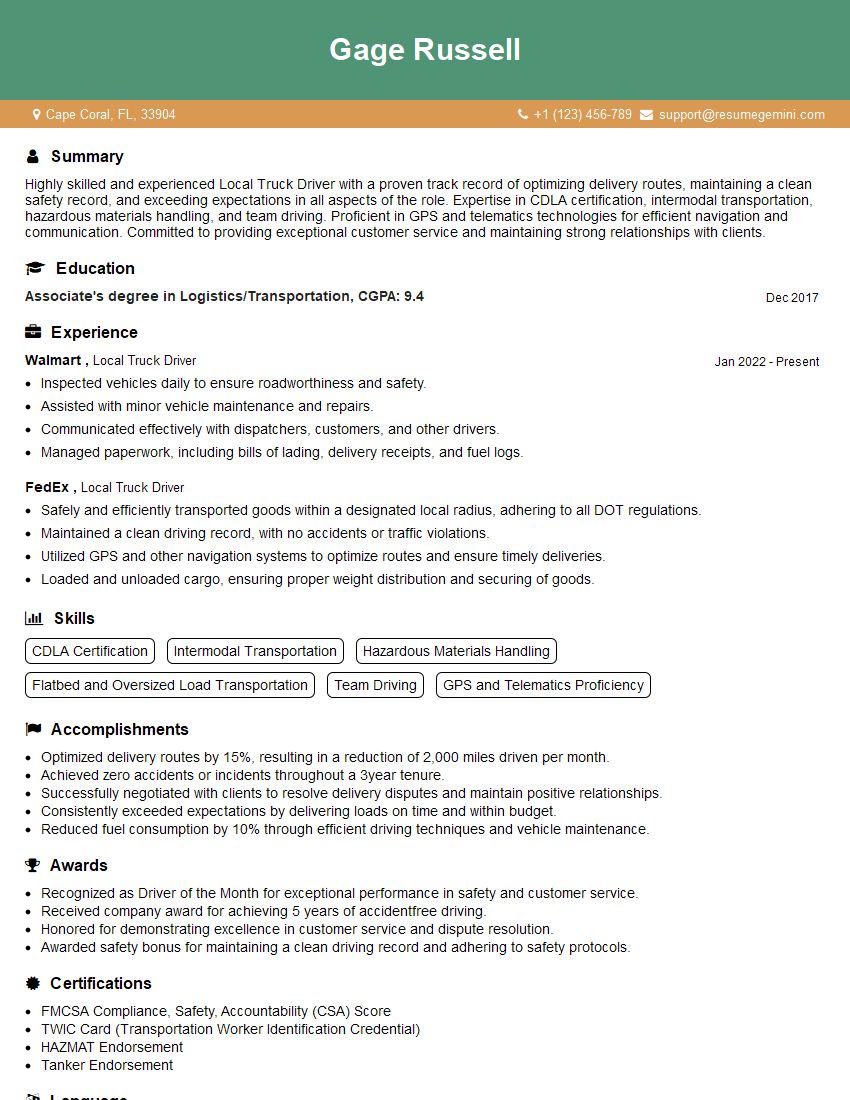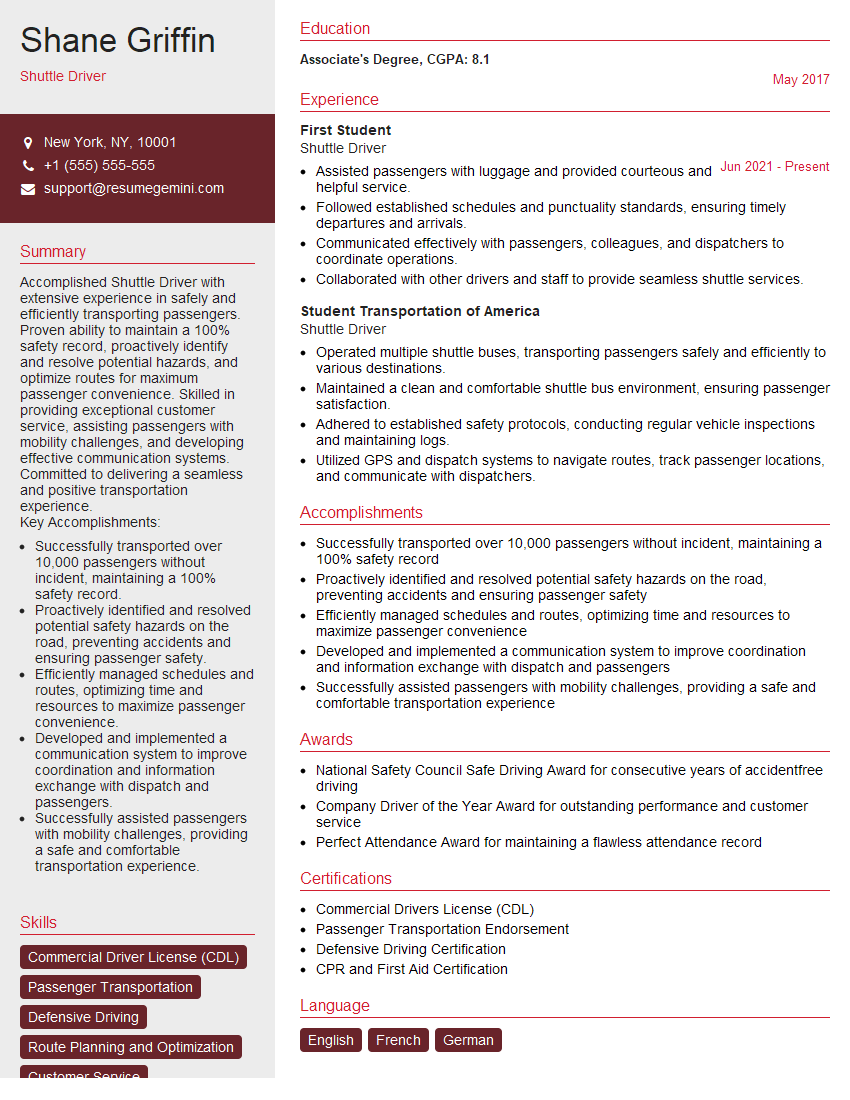Unlock your full potential by mastering the most common Truck or Van Driving interview questions. This blog offers a deep dive into the critical topics, ensuring you’re not only prepared to answer but to excel. With these insights, you’ll approach your interview with clarity and confidence.
Questions Asked in Truck or Van Driving Interview
Q 1. What types of endorsements do you hold on your CDL?
My Commercial Driver’s License (CDL) currently holds endorsements for HAZMAT (hazardous materials) and Doubles/Triples. The HAZMAT endorsement allows me to transport hazardous materials, requiring specialized training and adherence to strict regulations concerning securement and handling. The Doubles/Triples endorsement permits me to operate vehicles towing two or three trailers, demanding exceptional skill in maneuvering and maintaining control of a much longer and heavier vehicle combination. I’m also currently working towards obtaining my Tanker endorsement to broaden my capabilities and increase my employment options.
Q 2. Describe your experience with pre-trip inspections.
Pre-trip inspections are crucial for safety and preventative maintenance. My inspection follows a systematic approach, starting with a walk-around of the entire vehicle. I check tires for proper inflation and wear, inspecting the tread depth and looking for any cuts or bulges. I meticulously examine the lights, signals, and reflectors, ensuring they all function correctly. Under the hood, I check fluids – engine oil, coolant, brake fluid, power steering fluid – verifying levels and looking for leaks. I inspect the air brake system, including the air tanks, lines, and connections, listening for any leaks. I also check the steering, suspension, and exhaust system for any damage or wear. Finally, I thoroughly examine the cargo area, ensuring the load is properly secured to prevent shifting or damage during transit. I meticulously document any issues found in the driver’s logbook. For instance, I once discovered a cracked brake line during a pre-trip inspection, preventing a potential catastrophic brake failure on the road. This systematic process ensures that the vehicle is roadworthy and reduces the risk of breakdowns and accidents.
Q 3. What are the different types of braking systems used in trucks?
Trucks utilize various braking systems, primarily focused on safety and control. The most common is the air brake system, using compressed air to activate brake chambers on the wheels. This system offers high stopping power, especially crucial for heavy loads. Anti-lock Braking Systems (ABS) are mandatory in most commercial vehicles; they prevent wheel lockup during braking, improving steering control and reducing stopping distance, particularly on slippery surfaces. Exhaust brakes, sometimes called Jake brakes, use engine compression to slow the vehicle, reducing wear on the service brakes, especially useful on downhill grades. Finally, retarder systems, such as hydraulic retarders, use fluid friction to slow the vehicle, offering additional braking assistance, especially beneficial during long descents. Understanding the interaction and limitations of each system is critical for safe operation in various conditions.
Q 4. How do you maintain a safe following distance?
Maintaining a safe following distance is paramount for preventing rear-end collisions. I use the three-second rule as a guideline. After the vehicle in front passes a fixed point (like a sign or landmark), I count one-thousand-one, one-thousand-two, one-thousand-three. If I reach the same point before I finish counting, I’m following too closely. This rule accounts for reaction time and braking distance, providing a safety buffer. I adjust this distance based on weather conditions; in rain or snow, I increase the following distance significantly to allow for longer braking distances. Furthermore, I avoid tailgating, keeping a conscious buffer to react to unexpected maneuvers from the vehicle ahead. This proactive approach has helped me avoid several near misses over my career.
Q 5. Explain your understanding of hours of service regulations.
Hours of Service (HOS) regulations are designed to prevent driver fatigue, a major cause of accidents. These regulations limit the number of hours a driver can operate a commercial motor vehicle within a given period. Key components include daily driving limits (typically 11 hours), a 14-hour on-duty limit, and mandatory rest periods. Electronic Logging Devices (ELDs) automatically track driving time and ensure compliance. Understanding and adhering to these regulations is not just a legal requirement but a crucial element of road safety. I meticulously track my hours and ensure sufficient rest to maintain alertness and prevent fatigue. Failure to adhere to these regulations can result in serious penalties and, more importantly, endanger lives.
Q 6. What are your strategies for fuel efficiency?
Fuel efficiency is a critical concern in trucking. My strategies focus on several key areas. Smooth driving is paramount; I avoid harsh acceleration and braking, maintaining consistent speeds whenever possible. I anticipate traffic flow and plan my route to minimize idling and unnecessary stops. Proper tire inflation is essential as under-inflated tires increase rolling resistance. I regularly check tire pressure and ensure they’re properly inflated. Maintaining the vehicle’s overall condition is vital; regular maintenance prevents mechanical issues that can reduce fuel economy. I also utilize predictive cruise control where available, helping maintain a consistent speed while adjusting for inclines and declines. These combined strategies significantly impact fuel consumption and contribute to the overall profitability of operations.
Q 7. How do you handle challenging weather conditions while driving?
Driving in challenging weather conditions requires extra caution and preparedness. In rain or snow, I significantly reduce my speed, increasing my following distance. I use my headlights to improve visibility and ensure my vehicle is equipped with proper tires for the conditions. Strong winds can affect vehicle control, especially with high-profile loads. I adjust my driving style accordingly, taking extra care when passing other vehicles or navigating curves. In fog or low-visibility situations, I proceed with extreme caution, utilizing low-beam headlights and fog lights to maintain visibility. If conditions become too dangerous, I will pull over to a safe location and wait until conditions improve before resuming my journey. Safety is always the top priority when facing inclement weather.
Q 8. Describe your experience with loading and unloading cargo.
Loading and unloading cargo efficiently and safely is paramount in trucking. My experience spans various cargo types and loading methods, from using forklifts and pallet jacks to manually handling smaller packages. I always prioritize safety, using proper lifting techniques to avoid injury and ensuring the cargo is evenly distributed to maintain balance and stability. For example, when loading a pallet of fragile ceramics, I would carefully position it away from heavier items and ensure it’s properly secured to prevent movement during transit. With bulkier items, I would strategically place them to optimize space and weight distribution, considering the center of gravity. I’m also adept at working with different loading dock equipment and ensuring efficient workflow with warehouse personnel.
Q 9. How do you secure cargo to prevent shifting or damage?
Securing cargo is crucial to prevent accidents and damage. My approach involves a multi-step process: first, I assess the cargo’s weight, size, and fragility. Then, I select the appropriate securing methods, such as straps, chains, or nets, based on the cargo and the type of trailer. Each item is carefully positioned, and I always use enough securing points to prevent shifting. For example, I wouldn’t rely solely on straps for a heavy load; I’d use both straps and chains and ensure they are properly tensioned, leaving no slack. For extra protection, I’ll often use anti-slip mats to prevent movement, especially for fragile items. I meticulously inspect the securing before departure and make any necessary adjustments. I am fully compliant with all DOT regulations regarding cargo securement.
Q 10. What is your experience with Electronic Logging Devices (ELDs)?
I’m highly proficient in using Electronic Logging Devices (ELDs). I understand the importance of accurate record-keeping for compliance with Hours of Service (HOS) regulations. I’m familiar with all ELD functionalities, including logging driving time, on-duty time, and off-duty time. I know how to properly edit or correct errors according to FMCSA guidelines, and I always ensure the device is properly connected and functioning correctly. I understand the impact of ELDs on my daily operations and actively use them to manage my hours efficiently and avoid violations. This includes planning my routes to account for break times and ensuring sufficient rest periods.
Q 11. Describe a time you had a mechanical issue on the road. How did you resolve it?
During a cross-country haul, I experienced a tire blowout on a remote stretch of highway. My immediate response was to safely pull over to the emergency lane, activate my hazard lights, and assess the situation. I checked for any immediate dangers before exiting the vehicle. Since it was a late-night incident, I called for roadside assistance and also contacted my dispatcher. While waiting, I placed warning triangles at a safe distance to alert other drivers. Once the roadside assistance arrived, they changed the tire. I inspected the tire and the wheel for any further damage before continuing my journey. This incident highlighted the importance of regular vehicle maintenance and the necessity of having emergency procedures in place.
Q 12. How do you handle aggressive or impatient drivers?
Dealing with aggressive or impatient drivers requires patience and a defensive driving approach. My priority is always safety. I avoid engaging in confrontations and maintain a safe following distance. If a driver is tailgating, I might slow down slightly to increase the distance. I try to remain calm and professional, focusing on controlling my own driving and adhering to traffic laws. If their behavior becomes truly dangerous, I’ll make a note of their license plate number and report it if necessary. I understand that everyone drives differently; my job is to ensure I and my cargo get to our destinations safely.
Q 13. Explain your understanding of different types of cargo and their handling requirements.
My experience encompasses handling various cargo types, each with unique handling requirements. For example, transporting hazardous materials (HazMat) requires specialized training, certifications, and adherence to strict regulations concerning placarding, securing, and emergency response procedures. I am familiar with handling refrigerated goods, understanding the importance of maintaining proper temperature settings. I’m also experienced with oversized and overweight loads, which require special permits and meticulous planning for route selection and securement. Handling fragile goods requires extra care, using protective measures like padding and bracing to prevent damage. I always refer to the bill of lading for detailed instructions and special handling notes.
Q 14. What is your experience with navigating using GPS and maps?
I’m highly proficient in using GPS and maps for navigation. I rely on GPS for efficient route planning and to avoid traffic congestion or road closures. I also use paper maps as backup in case of GPS malfunction or loss of service. I understand the importance of regularly updating map data to ensure accuracy. My navigational skills extend to interpreting various map symbols, understanding route designations, and identifying landmarks. For example, I can anticipate potential route challenges such as narrow bridges or low clearance areas and adjust my route accordingly. I prioritize safe and efficient navigation to make timely deliveries while ensuring driver and cargo safety.
Q 15. How do you manage your time effectively to meet delivery deadlines?
Effective time management is crucial for meeting delivery deadlines in trucking. It’s not just about driving fast; it’s about strategic planning and efficient execution. My approach involves several key steps:
- Pre-Trip Planning: Before even starting the engine, I meticulously review the route, considering traffic patterns, potential delays (construction, accidents), and delivery windows. I utilize GPS navigation and often check real-time traffic updates to optimize my route.
- Prioritization: If I have multiple deliveries, I prioritize them based on urgency and delivery deadlines. Time-sensitive deliveries get tackled first. I also factor in loading and unloading times at each stop.
- Maintaining a Consistent Pace: I drive safely and consistently within speed limits, avoiding aggressive driving which can lead to delays or accidents. Regular breaks are essential to maintain focus and prevent fatigue.
- Communication: Proactive communication is key. If I anticipate a delay, I immediately inform dispatch and the recipient. This prevents misunderstandings and allows for adjustments to be made.
- Documentation: Accurate record-keeping of arrival and departure times, along with any unforeseen delays, provides essential data for future route planning and performance analysis.
For example, on a recent multi-stop run, I anticipated heavier traffic in a certain area during rush hour. I adjusted my route to avoid it, using a slightly longer but faster alternative road, ensuring all deliveries were made on time.
Career Expert Tips:
- Ace those interviews! Prepare effectively by reviewing the Top 50 Most Common Interview Questions on ResumeGemini.
- Navigate your job search with confidence! Explore a wide range of Career Tips on ResumeGemini. Learn about common challenges and recommendations to overcome them.
- Craft the perfect resume! Master the Art of Resume Writing with ResumeGemini’s guide. Showcase your unique qualifications and achievements effectively.
- Don’t miss out on holiday savings! Build your dream resume with ResumeGemini’s ATS optimized templates.
Q 16. What is your experience with using a two-way radio or communication device?
I have extensive experience using two-way radios and other communication devices. Clear and concise communication is paramount for safety and efficiency in this profession. My experience includes:
- Dispatch Communication: Regularly communicating with dispatch regarding location, estimated time of arrival (ETA), and any issues encountered (e.g., traffic jams, mechanical problems).
- Yard Communication: Coordinating with loading and unloading personnel to ensure smooth and efficient operations.
- Emergency Situations: Utilizing the radio to report accidents or other emergencies to dispatch and relevant authorities.
- Professional Etiquette: Maintaining professional and respectful communication at all times, using clear and concise language to avoid misunderstandings.
I’m proficient in using various communication channels, from traditional CB radios to newer digital systems, ensuring effective communication regardless of the technology used. For instance, during a recent winter storm, I used the radio to communicate with dispatch about hazardous road conditions, allowing them to reroute other drivers and prioritize my safety.
Q 17. How do you prioritize safety in your daily driving tasks?
Safety is my top priority. It’s not just a rule; it’s a mindset that integrates into every aspect of my job. My safety practices include:
- Pre-Trip Inspections: Thorough vehicle inspections before every trip, checking tires, lights, brakes, and other critical components. This prevents mechanical failures on the road.
- Defensive Driving: Anticipating potential hazards and reacting proactively to avoid accidents. Maintaining a safe following distance, adjusting speed for weather conditions, and avoiding distractions (like cell phones) are crucial.
- Compliance with Regulations: Strictly adhering to all traffic laws, speed limits, and hours-of-service regulations. Driver fatigue is a major safety hazard, and I prioritize sufficient rest.
- Load Securement: Properly securing cargo to prevent shifting and potential accidents. This is especially critical with different types of cargo and trailers.
- Vehicle Maintenance: Reporting any mechanical issues to dispatch promptly for timely repairs.
I always remember a time when a fellow driver had an accident due to improper load securement. This reinforced the importance of meticulous pre-trip inspections and careful load securing.
Q 18. What is your experience with managing paperwork and delivery documentation?
Accurate and timely paperwork is essential for efficient delivery operations. My experience includes:
- Bill of Lading (BOL): Accurately completing BOLs, verifying cargo details, and obtaining signatures upon delivery.
- Delivery Receipts: Obtaining proper signatures and documentation confirming successful deliveries.
- Electronic Logging Devices (ELDs): Proficiently using ELDs to accurately track driving hours and maintain compliance with regulations.
- Maintenance Logs: Recording vehicle maintenance and repair information.
- Incident Reporting: Documenting any accidents, incidents, or delays.
I’m adept at utilizing both paper-based and electronic documentation systems, ensuring accuracy and compliance at all times. A well-maintained record minimizes errors and ensures timely reimbursement and efficient accounting processes.
Q 19. Describe your experience with working independently and as part of a team.
I’m comfortable working both independently and as part of a team. Truck driving often involves periods of solitary work, demanding self-reliance and discipline. However, successful operations depend on team collaboration.
- Independent Work: I’m highly self-motivated and able to manage my time and workload effectively without constant supervision. I take initiative and proactively address any challenges that arise.
- Teamwork: I effectively communicate with dispatch, loading/unloading crews, and other drivers, ensuring smooth coordination and efficient operations. I’m always willing to lend a hand to colleagues when needed.
For instance, I’ve often helped fellow drivers with securing their loads or provided assistance during unexpected delays. My ability to work effectively both individually and collaboratively contributes to the overall efficiency of our team.
Q 20. How do you handle customer interactions and address customer concerns?
Positive customer interactions are crucial. I approach each interaction with professionalism and respect, focusing on efficient and courteous service.
- Professionalism: Maintaining a professional demeanor, addressing customers politely, and clearly communicating delivery information.
- Problem-Solving: Addressing customer concerns promptly and efficiently, finding solutions within company policies and procedures.
- Communication: Keeping customers informed of delivery status, providing updates, and responding to any queries.
- Conflict Resolution: Approaching conflicts calmly and professionally, aiming for mutually satisfactory solutions.
For example, I once had a customer who was unhappy about a slight delay. By explaining the situation and offering sincere apologies, I managed to resolve the issue, leaving the customer satisfied.
Q 21. What is your experience with different types of trailers (e.g., flatbed, refrigerated)?
My experience encompasses various trailer types, each requiring specialized handling and knowledge.
- Flatbed Trailers: Experienced in securing various types of cargo, including oversized or irregularly shaped loads, using appropriate tie-down techniques.
- Refrigerated Trailers (Reefer): Proficient in operating and monitoring reefer units, ensuring proper temperature control for perishable goods. I understand the importance of pre-trip inspections and monitoring temperature throughout the transit.
- Dry Van Trailers: Handling standard enclosed trailers, carefully loading and unloading various types of goods to prevent damage.
- Other Trailers: Familiar with the basic operation and safety procedures for other trailer types (e.g., tankers, lowboys) although my specialization is in flatbed and reefer trailers.
My experience with different trailer types has enabled me to adapt to various cargo and delivery requirements efficiently and safely. Understanding the nuances of each trailer type is essential for preventing accidents and ensuring the safe delivery of goods.
Q 22. How do you ensure the safety of your cargo during transportation?
Securing cargo is paramount for safety and legal compliance. My approach is multifaceted and begins before the load even leaves the dock. I meticulously inspect the vehicle to ensure proper tie-down points are available and in good condition. Then, I carefully assess the cargo itself, noting its weight, dimensions, and any potential fragility.
For example, if I’m transporting fragile electronics, I’ll use appropriate padding and bracing to prevent shifting during transit. Heavier items, like pallets of building materials, require secure straps and proper weight distribution to maintain balance and prevent rollovers. I always ensure that the cargo is evenly distributed to prevent instability and maintain the vehicle’s center of gravity. I always double-check my work before departure, ensuring all straps are taut and secure and that nothing is protruding that could become a hazard. After driving for a while, I’ll perform a quick visual check of the load in my mirrors to ensure nothing has shifted.
Regularly scheduled inspections are also crucial. If I notice any issues during the trip, I pull over to a safe location to address them immediately. Safety is my top priority, and it’s a process that requires constant vigilance.
Q 23. What are the different types of driving routes you are comfortable with?
I’m comfortable navigating a wide variety of routes, including highways, interstates, city streets, and even some unpaved roads depending on the vehicle and cargo. Highway driving requires a focus on maintaining speed and observing safe following distances, while city driving necessitates greater awareness of pedestrians, traffic lights, and other vehicles. Navigating tight city streets requires skillful maneuvering and a strong understanding of traffic laws. Rural routes, often involving two-lane roads and changing weather conditions, demand heightened awareness and caution. I’m adept at utilizing GPS navigation systems and route planning apps to efficiently and safely reach my destination, regardless of the route type.
My experience includes navigating various challenging routes, from mountainous terrain that require careful braking and speed management to congested urban areas requiring precise maneuvering and adherence to traffic laws. I am always prepared to adjust my driving style according to the prevailing conditions of the road.
Q 24. Explain your experience with using various vehicle controls (e.g., air brakes, automatic transmission).
I have extensive experience operating vehicles equipped with both air brakes and automatic transmissions. With air brakes, I understand the importance of regularly checking air pressure and performing pre-trip inspections. Knowing how to properly apply and release the brakes is essential for safe operation, especially on steep grades or during emergency situations. I’m familiar with the warning signals and know how to troubleshoot common air brake issues. I am proficient in using the various air brake controls and understand the implications of any warning signs, acting appropriately to prevent accidents.
Automatic transmissions are straightforward, but I understand their limitations, particularly regarding load-bearing capacity and hill climbing. I know how to select the appropriate gear for various terrains and driving conditions. I’ve driven both manual and automatic transmission trucks and vans and have a solid understanding of their differences and limitations. This ensures I can optimize fuel efficiency and vehicle performance while prioritizing safety.
Q 25. How familiar are you with the Department of Transportation (DOT) regulations?
I am thoroughly familiar with DOT regulations, including Hours of Service (HOS) rules, vehicle maintenance requirements, and driver qualification standards. I understand the importance of maintaining accurate driver logs and adhering to weight limits. I’m aware of the consequences of non-compliance, ranging from fines to license suspension. I know that keeping current with all changes is crucial for safety and legality. For instance, I am aware of the specific requirements for carrying hazardous materials, including proper documentation and placarding. I stay informed about updates and changes to regulations through professional development and industry publications.
My understanding of DOT regulations extends beyond simply following the rules; it’s about incorporating them into my daily operations to ensure both my safety and the safety of others on the road.
Q 26. What is your experience with maintaining driver logs and records?
Maintaining accurate driver logs and records is a non-negotiable aspect of my job. I diligently record my hours of service, ensuring strict adherence to DOT regulations. I utilize electronic logging devices (ELDs) proficiently and understand the importance of maintaining accurate records. My logs are always complete, legible, and readily available for inspection. I know that falsifying records is a serious offense, and I take my responsibility seriously. I also understand the requirements for maintaining other relevant documents, such as vehicle maintenance records and permits.
Accuracy and timeliness are critical, not just for compliance but also for efficient trip planning and managing rest periods. I’ve never had any discrepancies in my records, demonstrating my commitment to maintaining integrity and accuracy in all my documentation.
Q 27. Describe your understanding of different road signs and their meanings.
My understanding of road signs is comprehensive, encompassing all shapes, colors, and meanings. I can readily interpret regulatory signs (speed limits, stop signs, yield signs), warning signs (curves, hills, intersections), and guide signs (route numbers, destinations). I understand the implications of different colors and symbols and apply them to adjust my driving accordingly. For example, a flashing yellow light means proceed with caution, while a flashing red light indicates a complete stop. Similarly, different shaped signs convey different types of warnings or information.
This knowledge ensures I’m always prepared for what lies ahead and can adjust my driving proactively to prevent accidents. Consistent and diligent attention to road signage is a crucial component of safe driving.
Q 28. How do you handle stressful situations while driving?
Stressful driving situations are inevitable. My approach involves maintaining a calm and focused demeanor. Deep breaths and reminding myself of safe driving practices help me stay centered. I prioritize defensive driving techniques, anticipating potential hazards and leaving ample space between my vehicle and others. I avoid aggressive driving behaviors and don’t engage in road rage. If I feel overwhelmed, I pull over to a safe location to take a break.
For example, if I encounter an aggressive driver, I avoid eye contact and maintain a safe distance. I don’t react emotionally but focus on maintaining control of my vehicle. In situations with heavy traffic or inclement weather, I adjust my speed accordingly, prioritizing safety over time constraints. My ability to remain calm and focused under pressure ensures safe and responsible driving.
Key Topics to Learn for Truck or Van Driving Interview
- Vehicle Operation & Maintenance: Understanding basic vehicle mechanics, pre-trip inspections, and routine maintenance procedures. Practical application includes describing your experience with preventative maintenance and troubleshooting minor issues.
- Safety Regulations & Compliance: Knowledge of federal and state regulations (e.g., hours of service, load securing, CDL requirements). Practical application includes demonstrating understanding of safe driving practices and adherence to regulations.
- Navigation & Route Planning: Efficient route planning, using GPS and mapping software, and understanding load limitations and delivery schedules. Practical application: Describing your experience optimizing routes for time and fuel efficiency.
- Communication & Customer Service: Professional communication with dispatchers, clients, and other drivers. Practical application: Providing examples of handling challenging situations with customers or colleagues professionally.
- Logistics & Supply Chain Management: Basic understanding of the supply chain process, inventory management, and efficient delivery strategies. Practical application: Demonstrating an understanding of how your role contributes to the overall efficiency of the logistics process.
- Defensive Driving Techniques: Understanding and applying defensive driving strategies to minimize accidents and ensure safety on the road. Practical application: Illustrating your ability to anticipate potential hazards and react safely.
- Emergency Procedures: Knowledge of emergency response protocols, including accident reporting and handling unexpected situations. Practical application: Explaining your ability to remain calm and react effectively in emergency situations.
Next Steps
Mastering truck or van driving offers excellent career growth opportunities, leading to increased responsibility, higher pay, and specialized roles. A strong resume is crucial for showcasing your skills and experience to potential employers. Creating an ATS-friendly resume significantly increases your chances of getting noticed. We highly recommend using ResumeGemini to build a professional and impactful resume that highlights your qualifications effectively. ResumeGemini provides examples of resumes tailored specifically for truck and van driving positions, ensuring your application stands out from the competition.
Explore more articles
Users Rating of Our Blogs
Share Your Experience
We value your feedback! Please rate our content and share your thoughts (optional).
What Readers Say About Our Blog
Hello,
We found issues with your domain’s email setup that may be sending your messages to spam or blocking them completely. InboxShield Mini shows you how to fix it in minutes — no tech skills required.
Scan your domain now for details: https://inboxshield-mini.com/
— Adam @ InboxShield Mini
support@inboxshield-mini.com
Reply STOP to unsubscribe
Hi, are you owner of interviewgemini.com? What if I told you I could help you find extra time in your schedule, reconnect with leads you didn’t even realize you missed, and bring in more “I want to work with you” conversations, without increasing your ad spend or hiring a full-time employee?
All with a flexible, budget-friendly service that could easily pay for itself. Sounds good?
Would it be nice to jump on a quick 10-minute call so I can show you exactly how we make this work?
Best,
Hapei
Marketing Director
Hey, I know you’re the owner of interviewgemini.com. I’ll be quick.
Fundraising for your business is tough and time-consuming. We make it easier by guaranteeing two private investor meetings each month, for six months. No demos, no pitch events – just direct introductions to active investors matched to your startup.
If youR17;re raising, this could help you build real momentum. Want me to send more info?
Hi, I represent an SEO company that specialises in getting you AI citations and higher rankings on Google. I’d like to offer you a 100% free SEO audit for your website. Would you be interested?
Hi, I represent an SEO company that specialises in getting you AI citations and higher rankings on Google. I’d like to offer you a 100% free SEO audit for your website. Would you be interested?
good
